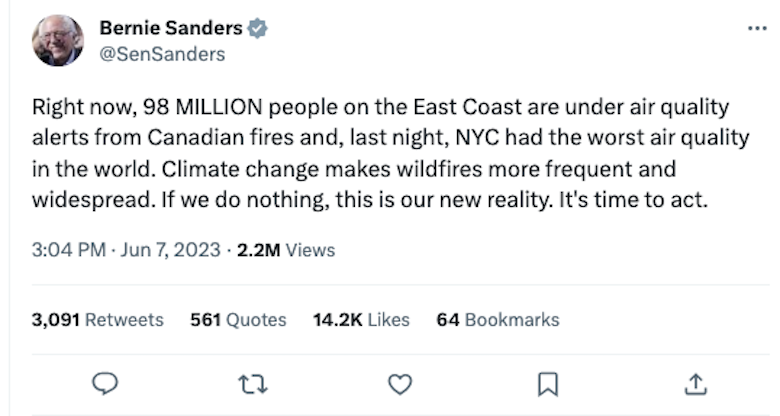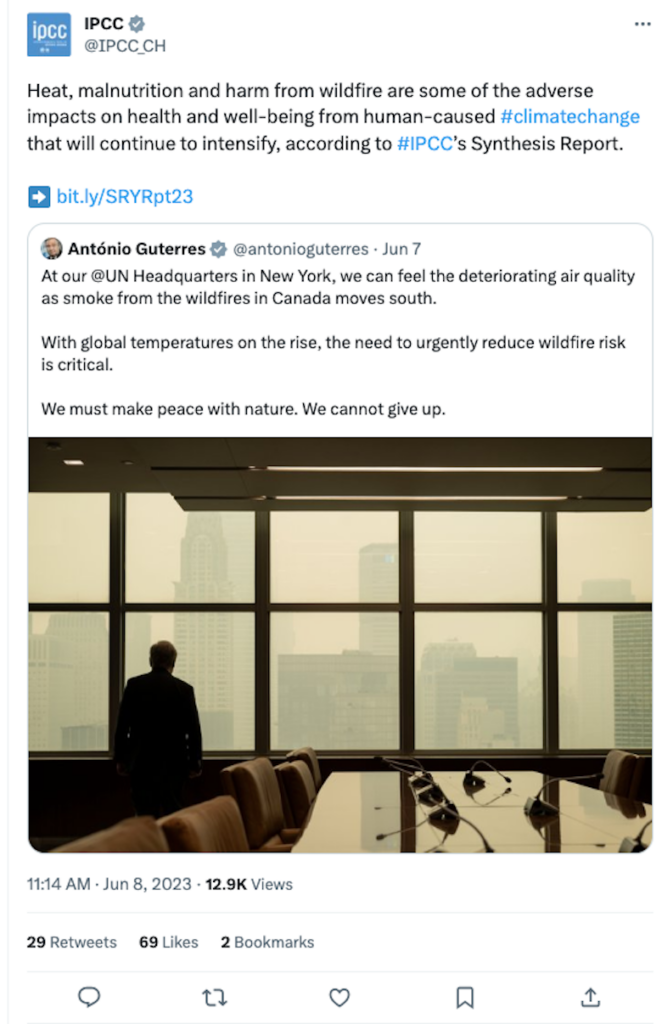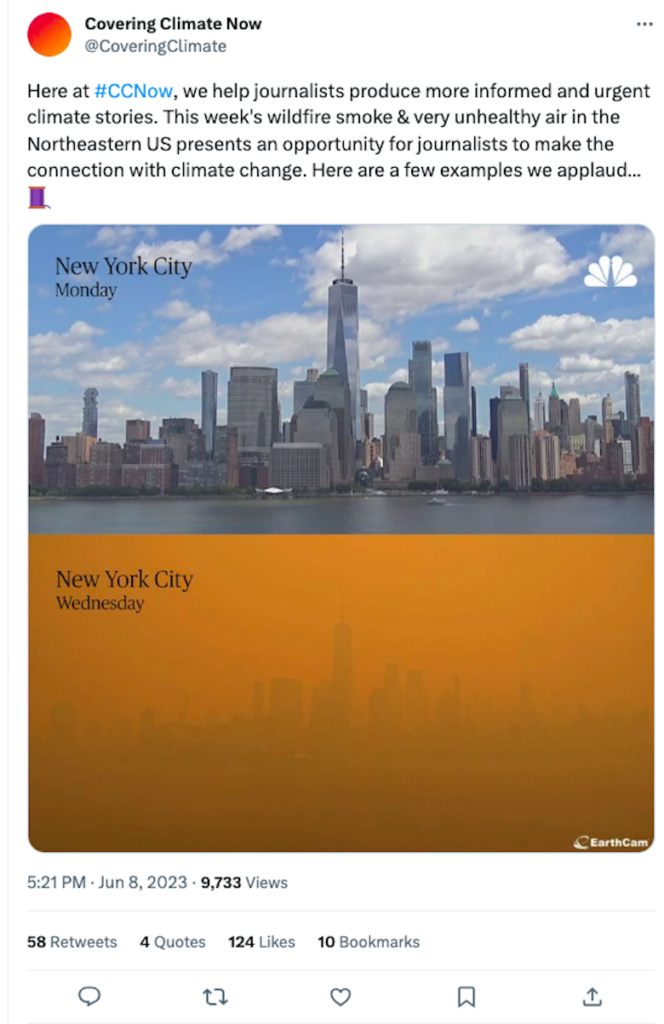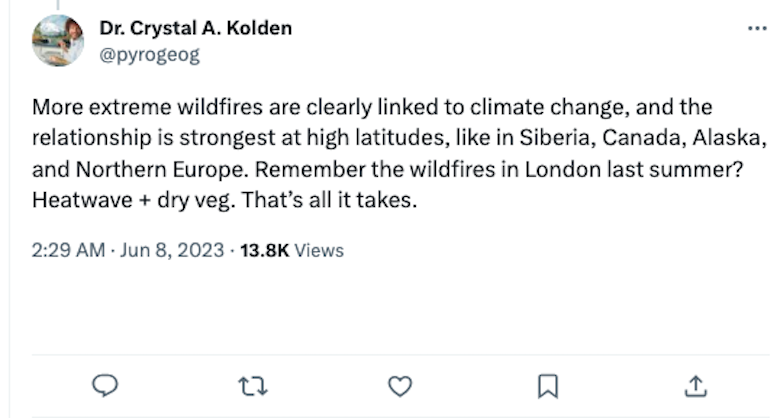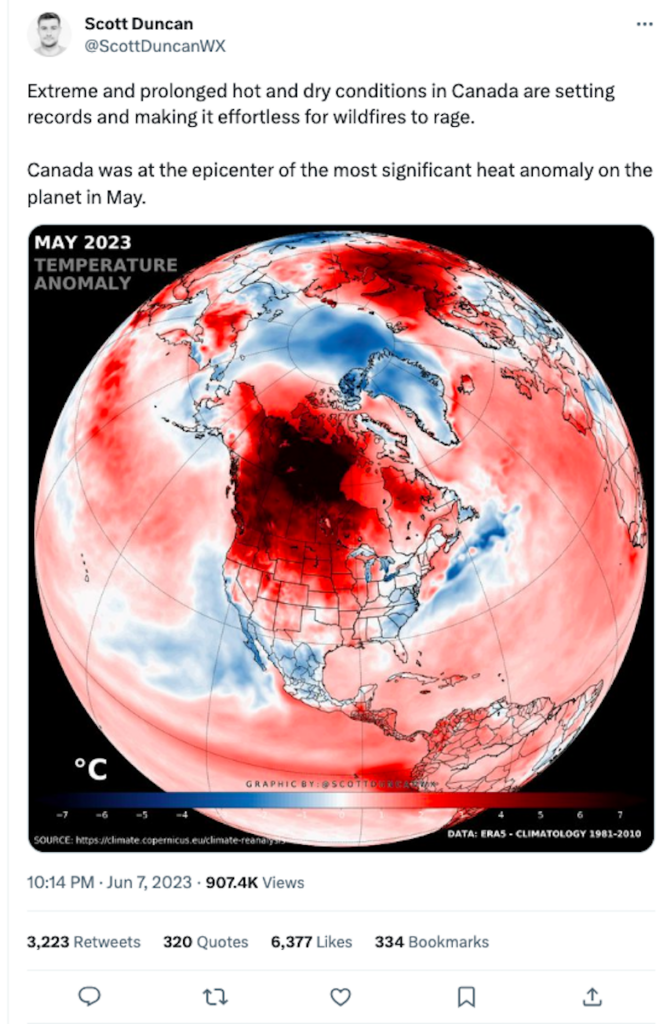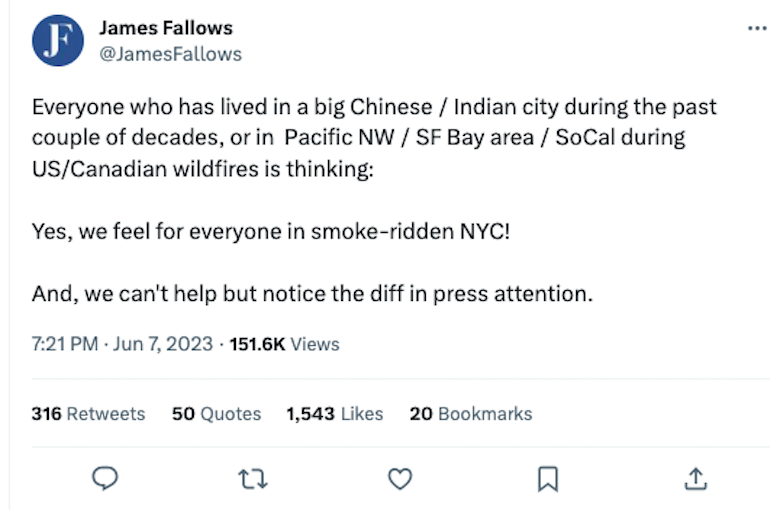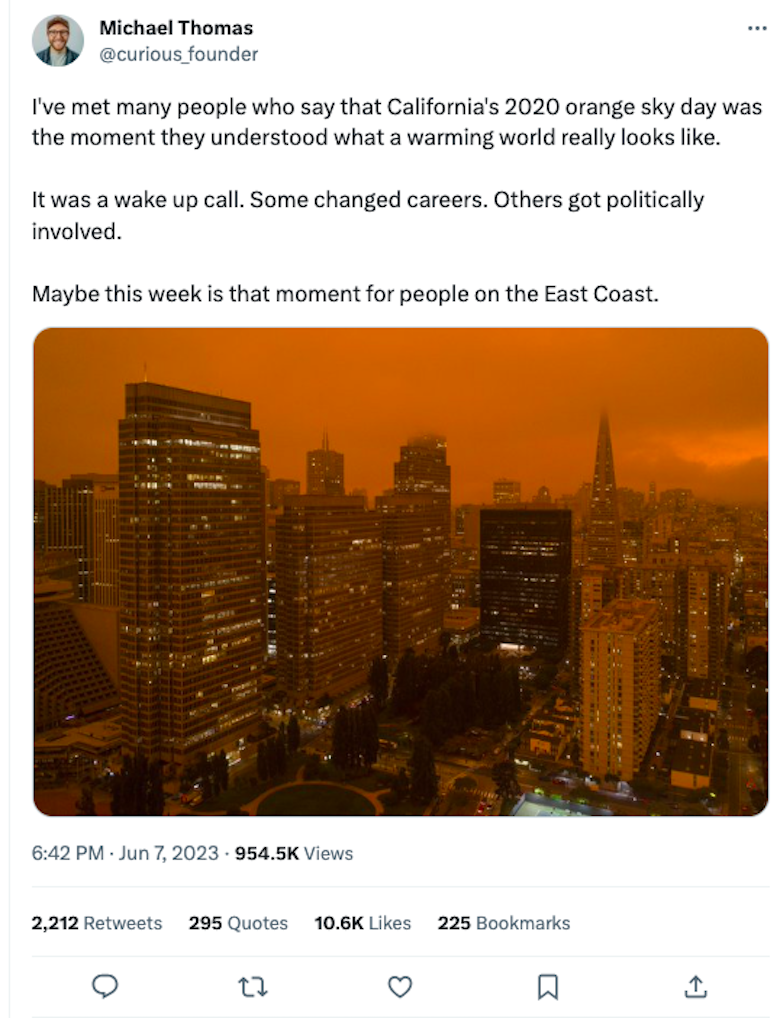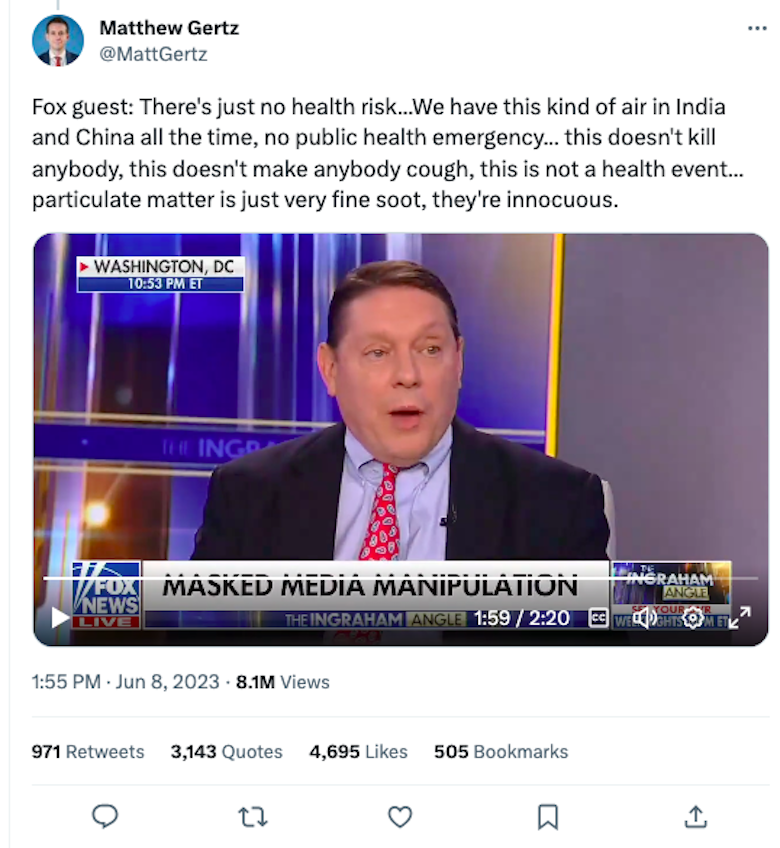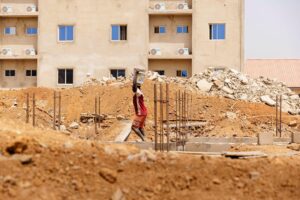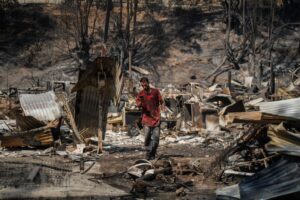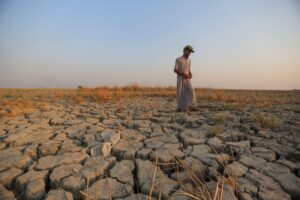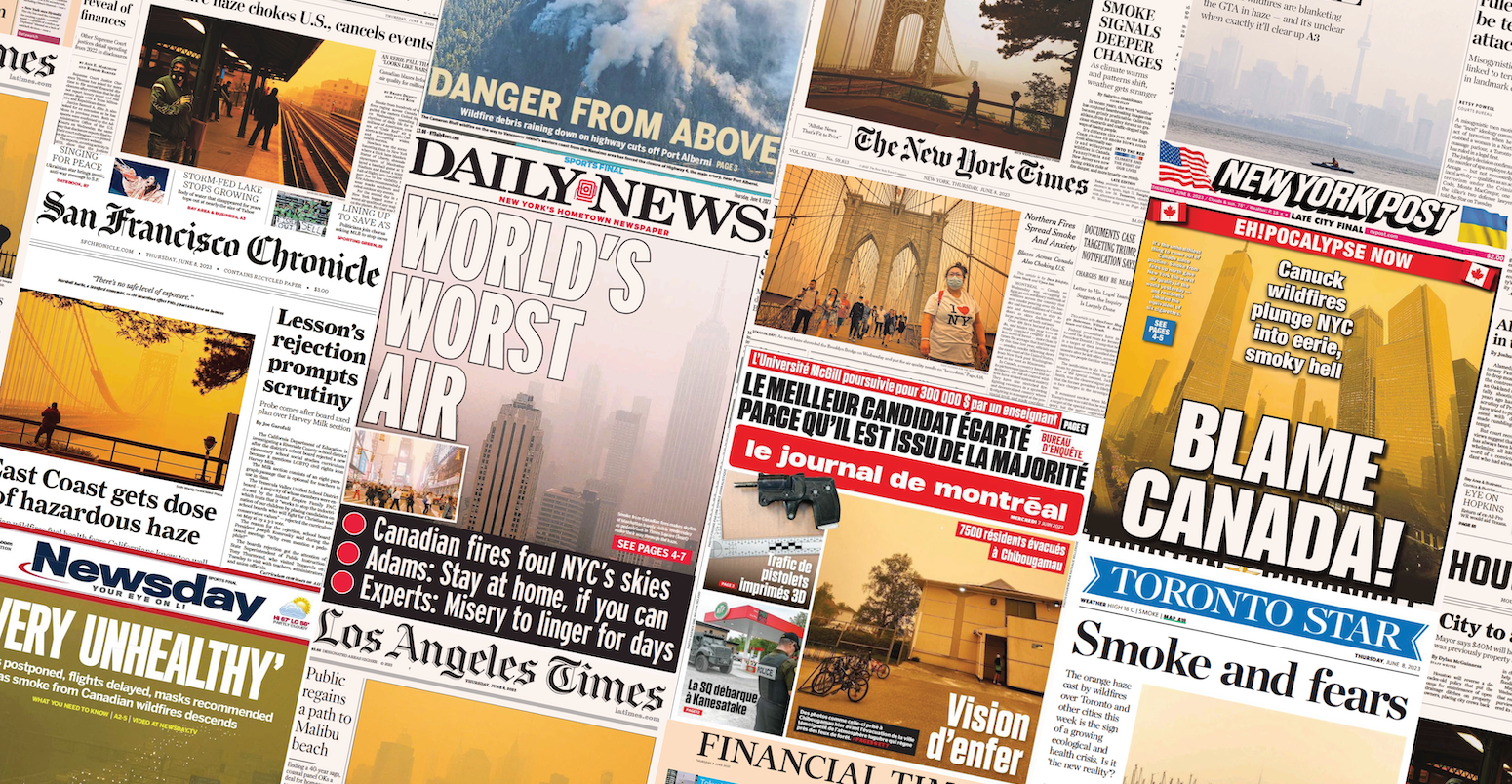
Media reaction: Canada’s wildfires in 2023 and the role of climate change
Multiple Authors
06.09.23Multiple Authors
09.06.2023 | 1:51pmHundreds of wildfires have been burning across Canada in what has been called an “unprecedented” start to the nation’s fire season.
Huge clouds of smoke from the blaze have blown thousands of kilometres down to the eastern US, shrouding cities such as New York and Washington DC in an orange haze and causing levels of toxic air pollution to reach record levels.
Scientists have been quick to make the link with climate change. The hot and dry conditions resulting from rising global temperatures are known to make wildfires more extreme.
Many US commentators said the fires should act as a “wake-up call” for climate action.
Meanwhile, the nation’s influential right-leaning media channels were quick to downplay the severity of the toxic smoke filling US streets.
In this article, Carbon Brief examines the role of climate change in the Canadian wildfires and how the media has responded.
- What is happening with the wildfires in Canada?
- What are the wider effects across North America?
- Does climate change have a role in driving the fires?
- How has the media responded to the wildfires?
What is happening with the wildfires in Canada?
In late April, forest fires began in British Columbia and Alberta, expanding to cover nine of Canada’s 13 provinces and territories. While wildfires are fairly common in the country’s western provinces, fires have opened new fronts, spreading to the eastern provinces of Nova Scotia, Quebec and Ontario, according to ABC News.
Quebec has been particularly affected, with multiple being started by lightning strikes, ABC continues. As of Tuesday 6 June, there were around 160 forest fires, which displaced some 10,000 people in the province alone, it added.
“The distribution of fires from coast to coast this year is unusual. At this time of the year, fires usually occur only on one side of the country at a time, most often that being in the west,” Michael Norton, an official with Canada’s Natural Resources ministry told Reuters.
The fires are taking place after the provinces of Alberta, Nova Scotia and Quebec experienced record heat this year, according to the Washington Post. Edmonton in Alberta, for example, saw average temperatures 6C above normal in May, hitting 17.2C, according to CBC.
Canada’s Atlantic region has also been experiencing droughts since February, with, for example, the town of Sydney, Nova Scotia, receiving only 15% of normal moisture in April, the paper says. Parts of the Atlantic region, including Nova Scotia, New Brunswick, Prince Edward Island and Newfoundland, recorded their driest April on record, it adds.
As such, by the end of April, 49% of the Atlantic Region was classified as “abnormally dry or in moderate drought”, including 77% of the region’s agricultural landscape, according to the Canadian government.
Such conditions made wildfires more likely, according to the Washington Post, although it also noted that a long-running forest management practice of fire suppression in many provinces has caused combustible vegetation that fuels fires to build up and dry out on the forest floor, playing a role in the severity.
55 million+ people across the US under air quality alerts.
— Mike Hudema (@MikeHudema) June 8, 2023
9 million acres charred by wildfires in Canada this year — 15x normal.
400+ fires still burning across Canada.
This is what the climate crisis looks like. No time to wait. #ActOnClimate #climate #energy #gorenewable pic.twitter.com/WzwGJJI5Oi
Forests cover about a third of the total land area or 3.62m km2 of Canada. As of Thursday, around 2,300 wildfires had burned roughly 42,897 km2, according to Reuters. The newswire says this is more than 15 times the 10-year average for this time of year.
More than half of the 437 active fires across Canada – some 248 – were out of control as of Thursday morning, according to the Canadian Interagency Forest Fire Center (CIFFC). With the hottest and driest period of the year still to come, the country is on track for its “worst ever” wildfire season, according to Reuters.
Across Canada, more than 20,000 people have been evacuated as firefighters continue to tackle the blazes, according to the Associated Press. To support this, firefighters from the US, South African, Australia, New Zealand, France, Portugal and Spain have been deployed in the country, Reuters reports.
200+ South African firefighters landed in Edmonton, Canada to assist in the fight against the raging wildfire. 🇿🇦🇨🇦pic.twitter.com/flXKqlvYxG
— Made In Canada (@MadelnCanada) June 8, 2023
A day after he spoke to Canadian prime minister Justin Trudeau, US president Joe Biden said in a statement on Thursday:
“Since May, more than 600 US firefighters, support personnel and firefighting assets have been deployed, working alongside Canadian firefighters to tackle what is likely to be the worst fire season in Canadian history and one that has huge impacts here in the US.”
Earlier this week, the Canadian government outlined a number of measures it was taking in response to the wildfires, including approving requests for federal assistance from the provinces of Alberta and Nova Scotia, partnering with provincial and territorial governments, and launching a “Wildfire Resilient Futures Initiative” with a proposed investment of $284m.
In a statement released alongside the announcements, Steven Guilbeault, minister of environment and climate change, made a clear link between the threat of wildfires and global warming. He said:
“We are already seeing one of the worst wildfire seasons on record and we must prepare for a long summer. The government of Canada is stepping up to the request for assistance from Quebec and will immediately begin mobilising Canadian Armed Forces, firefighting resources and assistance with planning to support the wildfire response in the province.
“The threat of increased fires due to climate change is one of the many reasons our government is developing a robust national adaptation strategy with all levels of government and Indigenous groups, so we can be sure our communities are well prepared for the impacts of climate change.”
What are the wider effects across North America?
Haze blanketed much of the eastern US this week as prevailing winds carried the smoke southwards from Canada.
At least 100 million Americans – nearly one-third of the US population – were under air-quality alerts on Wednesday, with the smoke spreading as far west as Chicago and as far south as Atlanta, according to USA Today.
The north-east, including major population centres such as New York City, Philadelphia and Washington DC, bore the brunt of the haze. Reuters reported that New York City temporarily had the world’s worst air quality of any major city on Wednesday afternoon. On Thursday, CBS News Philadelphia noted that that city now had the world’s worst air quality.
The Toronto Star wrote on Thursday that the city was “brac[ing] for what might be the worst air quality levels it has ever seen”, warning readers that Toronto’s air quality index might approach the levels seen in New York the previous day.
Check out this almost unbelievable time-lapse of wildfire smoke consuming the World Trade Center and the New York City skyline.
— NWS New York NY (@NWSNewYorkNY) June 7, 2023
Those vulnerable to poor air quality, including seniors and young children, should limit time outdoors if possible.
More: https://t.co/ChRuWv7X6E pic.twitter.com/mtKtLun8lN
Heatmap News wrote that air quality in the eastern US “has reached the worst level since 2005, when modern records began”. The piece noted that the air quality on the east coast “was comparable” to that regularly seen on the west coast during fire season, but added that “it is unheard of for such toxic air to afflict such a densely populated part of the country”.
The Atlantic advised: “It is, to put it lightly, an absolutely terrible time to go outside.” The piece noted that “masks are being urged as a precaution against the thick, choking plumes of smoke from Canada”.
The Federal Aviation Administration temporarily grounded or otherwise restricted flights into several east coast airports on Wednesday and Thursday, according to CNN.
Taking a look west from the top of the Washington Monument. You can make out the Lincoln Memorial and Potomac River some. But Virginia is not visible. The other picture shows what it looked like 3 days ago. #dcwx #vawx pic.twitter.com/p5rRFowDRZ
— Peter Mullinax (@wxmvpete) June 8, 2023
All along the east coast, sporting events – including baseball games, indoor basketball games and horse racing – were cancelled or postponed due to unsafe air quality on Wednesday and Thursday, the Associated Press reported.
The Washington Post reported that several New York City theatres had also cancelled performances on Wednesday. The White House postponed its pride month event, originally scheduled for Friday, to Saturday, according to Bloomberg.
Reuters wrote that “schools up and down the east coast called off outdoor activities, including sports, field trips and recesses”; New York City public schools announced on Thursday that Friday would be a remote-instruction day. Washington, DC suspended some non-essential city services, such as roadwork and rubbish collection, according to the local outlet DCist.
Axios reported that the US had dispatched more than 600 “firefighting personnel”, as well as firefighting equipment, to help battle the blazes in Canada.
US senator Bernie Sanders and New York representative Alexandria Ocasio-Cortez, both Democrats, took to Twitter to “issue stark warning[s]” about the connection between the wildfires and climate change, the Independent wrote.
Meanwhile, the New Republic criticised US representative Marc Molinaro, a Republican, for saying “this isn’t the moment to start lecturing people about the science of climate change”. The New Republic wrote:
“It’s almost comical the extent Republican politicians will go to deny reality…While nearly a third of the country is at risk of breathing in a dark haze straight out of dystopia, Republicans are still lecturing us for having the nerve to say enough is enough.”
Does climate change have a role in driving the fires?
There is a wide body of evidence to show that climate change is making wildfire conditions more likely in many parts of the world.
A report from the Intergovernmental Panel on Climate Change (IPCC) published in 2021 said that greenhouse gas emissions have “led to an increased frequency and/or intensity of some weather and climate extremes” – such as floods, drought and wildfires.
For example, dry conditions intensified by climate change can cause fires to spread more quickly over large areas.
The IPCC said with high confidence that “compound hot and dry conditions become more probable in nearly all land regions as global mean temperature increases”.
Similar conditions can also be created by long periods of drought, Dr Cristina Santin, a wildfires researcher from Swansea University previously told Carbon Brief.
There is an increasing risk of forest fires in North America, the IPCC said, and the fire season across this region “expands dramatically”, if global warming exceeds 2C.
In the western US, climate change has made – and will continue to make – fires larger and more destructive, Carbon Brief reported in 2018.
No attribution studies have so far made a climate connection with the ongoing wildfires in Canada.
But previous studies have looked at the link between climate change and other extreme weather events. One study found that climate change made a 2020 Siberian heatwave at least 600 times more likely. This heat broke temperature records and led to wildfires.
Additionally, the IPCC said that wildland fire has been “identified as a top climate-change risk facing Canada”.
The interactive map below displays a 2020 review of scientific studies finding that climate change is increasing the risk of wildfires globally.
Interactive map displaying 73 studies included in Science Brief’s review on wildfires and climate change. Data source: Science Brief. Map by Tom Prater and Joe Goodman for Carbon Brief.News outlets and experts have also been making the climate connection in recent days.
Mohammadreza Alizadeh, a researcher at McGill University in Montreal, told the Guardian that the Canadian fires are a “really clear sign of climate change”.
“The climate signal is very strong” given the size and severity of the fires, according to Robert Scheller, a professor of forestry at North Carolina State University, quoted by BBC News.
Experts have “pointed to a warmer and drier spring than normal” as the reason for heightened wildfire conditions in Canada, another BBC News piece said, adding:
“Fires across Canada have already burned more than 3.8m hectares (9.4m acres) of land – an area 12 times the 10-year average for this time of year.”
According to Al Jazeera, New York City mayor Eric Adams told a press briefing:
“While this may be the first time we’ve experienced something like this on this magnitude, let’s be clear: it is not the last. Climate change [has] accelerated these conditions.”
It is “unusual” for fires to occur “from coast to coast” at this time of the year, according to Michael Norton, an official with Canada’s Natural Resources ministry. He told Reuters:
“The rate of increase of area burned is also high…if this rate continues, we could hit record levels for area burned this year.”
The newswire further quoted Yan Boulanger, a researcher with Natural Resources Canada, who said that “partially because of climate change, we’re seeing trends toward increasing burned area throughout Canada”.
“Higher-than-normal” fire activity is possible across most of Canada during this year’s wildfire season due to ongoing drought and expected high temperatures, the country’s government said.
The fires “remind us that carbon pollution carries a cost on our society, as it accelerates climate change”, Steven Guilbeault, Canada’s environment and climate change minister, said on Twitter.
Elsewhere, however, a Yahoo News article said that, “while it may seem obvious to blame climate change for these extreme conditions, one expert clarifies that there’s more factors at play”.
Carbon Brief’s climate science contributor Dr Zeke Hausfather took a closer look at studies on Canada’s wildfires and climate change.
He wrote on his Substack that, while climate attribution studies are needed to assess the current fires, “it is clear that these sort of events are likely to become more common as the world warms”.
(For more details on how climate change affects wildfires, read Carbon Brief’s in-depth explainer from 2020.)
How has the media responded to the wildfires?
Media in Canada, the US and around the world covered the fires, the smoke and the eerie orange tint that settled on swathes of the eastern seaboard.
However, much of the ensuing commentary on the wildfires came from the US east coast. The location of some of the world’s most influential news organisations was blanketed in smoke, giving many journalists and news anchors first-hand experience of the event.
An editorial in the Washington Post said the fires were a sign that the US had to ramp up its preparations for climate change – for example, by assessing wildfire risks in areas previously considered too wet. It concluded:
“In some ways, the haze could be making everyone see more clearly what lies ahead.”
The idea that the wildfires should galvanise climate action was a common one. “Will nature’s smoke alarm serve as an American wakeup call?” asked Will Bunch, a columnist for the Philadelphia Inquirer. In his Washington Post column, Eugene Robinson wrote that, “once again, nature is sending us an unambiguous message”.
Concluding her account of a day spent in a smoke-choked New York, Carolyn Kormann wrote in the New Yorker: “We know the story of the climate crisis…Yet we live as though we do not, and we breathe the consequences.”
In his newsletter for the New York Times, David Wallace-Wells wrote that the fires could mark a shift in perceptions “away from the American West as the fountainhead of wildfire”.
From his home in Vermont, veteran climate activist and author Bill McKibben wrote in The Crucial Years, his Substack, that the fires brought people in the US closer to how “a huge percentage of the world’s people breathe every single day of their lives”. (He was referencing cities such as New Delhi and Beijing that have high rates of air pollution.)
Some, such as former Atlantic national correspondent James Fallows, pointed out what they viewed as a media bias towards the events on the east coast of the US.
Responding to this in his New York Times column, Paul Krugman wrote:
“That’s a minor issue compared with the importance of learning from these crises, now that enough influential people have seen with their own eyes what’s happening.”
Meanwhile, as clouds of smoke billowed through some of the nation’s largest cities, many right-leaning US news outlets responded with a shrug. Their attitude was summarised by a Rolling Stone article titled: “Right-wing media is saying the wildfire smoke is good, actually.”
The article quoted lobbyist Steve Milloy, a “big oil mouthpiece who has long denied climate change”, who appeared on Fox News host Laura Ingraham’s show and said:
“This doesn’t kill anybody, it doesn’t make anybody cough, this is not a health event…This has got nothing to do with climate. This is wildfire smoke. This is natural.”
Another Fox News host, Jeanine Pirro said it was “insanity” for people to wear masks to protect themselves from wildfire smoke. She also referenced a Fox News line that left-leaning politicians, such as Democrat congresswoman Alexandria Ocasio-Cortez, were “seiz[ing] on” the fires to push for a Green New Deal.
According to the Daily Beast, Sean Hannity, another popular Fox News host, asked a guest on the show if people complaining about breathing difficulties due to the smoke were merely “snowflakes”.
The NGO Media Matters for America summarised the coverage in a piece titled “with Canadian wildfires, Fox News follows its Covid playbook” – referencing the channel’s tendency to downplay the risks of the pandemic.
Greg Kelly, a host on another right-leaning news channel, Newsmax, attributed the smoke in New York to “our woke friends to the north in Canada” and also played down the risks, describing the smoke as “not an unpleasant odour, to be honest”.
An editorial in the climate-sceptic comment pages of the Wall Street Journal also took the opportunity of the fires to take aim at US climate policy, stating:
“Progressives are proclaiming that the smoky skies engulfing the eastern US from Canadian wildfires are another sign that the climate apocalypse is nigh. Instead, they’re a reminder that government policies to mitigate the impact of natural disasters matter more than those to reduce CO2 emissions.”
The newspaper said land management policies ”such as prescribed burns” to prevent wildfires spreading “would reduce CO2 emissions more than offshore wind or electric-vehicle mandates”. Australian columnist Miranda Devine wrote a piece in the New York Post echoing this sentiment, calling links to climate change “propaganda”.


